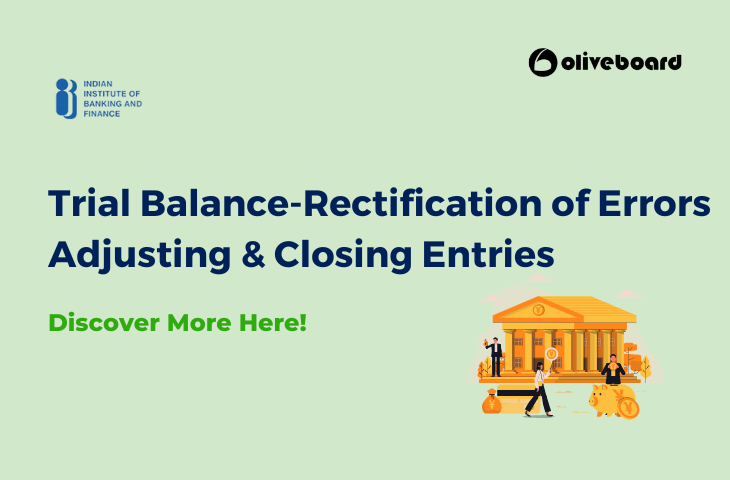A trial balance is a list of accounts and their current balances on a certain date. The account balances list is often prepared after the accounting cycle and is sorted by credit and debit balances. As trial balance is a key concept to be aware of, in this blog we are providing you with information regarding Trial Balance-Rectification of Errors and Adjusting & Closing Entries. Know how to download the ebook below.
Download Trial Balance-Rectification of Errors and Adjusting & Closing Entries E-Book
Download Trial Balance-Rectification of Errors and Adjusting & Closing Entries free e-book
How to Download Trial Balance-Rectification of Errors and Adjusting & Closing Entries E-book for JAIIB?
Step 1: Click on the download link. You will be redirected to Oliveboard’s FREE E-Books Page.

Step 2: Create a free Oliveboard account or login using your existing Oliveboard account details
Step 3: Download the book by clicking on the link presented on the page.
Introduction – Trial Balance
A trial balance is a list of accounts and their current balances on a certain date. The account balances list is often prepared after the accounting cycle and is sorted by credit and debit balances. The books must be reconciled before financial statements are created after a period, which means total debits must equal total credits. A trial balance is used to ascertain this.
In one column, debit balances are presented, while credit balances are listed in another. The totals in each column should be equal. The ledger is considered to be in balance when this happens. The purpose of preparing a trial balance for a corporation is to discover any double-entry accounting system arithmetic flaws. The trial balance is deemed balanced if the total debts match the total credits, and the ledgers should be free of mathematical mistakes.
Types of Errors
All errors can be categorised into one of four categories, depending on the nature of the error:
- Errors of Commission: These are mistakes that occur due to the incorrect transaction posting, wrong account totalling or balancing, the incorrect casting of subsidiary books, or incorrect amount recording in original entry books, among other things. For instance, Raj Vans Traders paid Preetpal Traders Rs. 25,000. (a supplier of goods). The cashbook appropriately recorded this transaction. However, Preetpal’s account was only debited with Rs. 2,500 after posting to the ledger.
- Errors of Omission: Omission mistakes might occur when the transaction is recorded in the books of initial entry or when it is posted to the ledger. There are two sorts of these: (i) full omission error or (ii) partial omission mistake. A full omission mistake occurs when a transaction is omitted from the books of the original record. For example, credit Mohan with Rs. 10,000 in sales that were not recorded in the sales book. A partial omission error occurs when a transaction is only partially recorded in the books. It would be a partial omission mistake if credit sales were properly entered in the sales book, but the transfer from the sales book to Mohan’s account was not completed.
- Errors of Principle: Accounting transactions are kept according to widely recognised accounting rules. Errors of principle occur when any of these principles are broken or neglected. For instance, money spent on building extensions should be considered capital expenditure and deducted from the asset account. Instead, this sum has been considered a revenue expenditure if it is credited to the maintenance and repairs account.
- Compensating Errors: Compensating errors occur when two or more errors are made in such a way that their combined effect on account debits and credits is zero. If the purchase book is overcast by Rs. 10,000, resulting in an excess debit of Rs. 10,000 in the purchases account and the sales returns book is undercast by Rs. 10,000, resulting in a short debit to the sales returns account; this is an example of two faults compensating for each other’s impact.
Purpose of a Trial Balance
- Debit balances are displayed in one column, while credit balances are displayed in another. Each column’s totals should be the same. When this happens, the ledger is said to be balanced.
- The goal of a trial balance for a firm is to identify any mathematical issues with the double-entry accounting system. If the total debits equal the total credits, the trial balance is considered balanced, and the ledgers should be free of mathematical errors.
- A ledger is a collection of entries from several accounts. The procedure of compiling all ledger balances and presenting them on a single sheet on a given date is known as trial balance. It helps the trader keep track of the quantities and amounts owed to clients and suppliers, and it makes the process of producing final accounting much easier.
- A trial balance difference might result from inaccurate ledger summing or balancing. Various errors may arise in totalling the values in subsidiary books, resulting in a trial balance disparity.
- It is usually completed after a fiscal year. However, depending on its needs, an organisation can create a trial balance at the end of any designated period, monthly, quarterly, half-yearly, or annually.
The following actions are done to prepare a trial balance:
- Determine the balances of each ledger account.
- Write down each account’s balance in the debit or credit column, as appropriate. (An account with a zero balance can be incorporated in the trial balance with a zero in the typical balance column.)
- Total the debit balances in the column.
- Add the credit balances column totals together.
- Double-check that the sum of the debit and credit amounts is equal.
- If they don’t add up, it means there are some mistakes.
- As a result, all account balances must be double-checked.
- All assets, costs and receivables accounts must have negative balances, whereas all liabilities, revenues, and payables accounts must have positive amounts.
Take a peek at Trial Balance-Rectification of Errors and Adjusting & Closing Entries E-book

FAQ’s
A. An accountant notes the discrepancy between the credit and debit sides of the trial balance as Suspense A/c when the Trial Balance does not balance due to one-sided accounting mistakes. As we locate and solve the errors, the amount in the Suspense A/c drops until it reaches zero.
A. A trial balance is a list of accounts and their current balances on a certain date. The account balances list is often prepared after the accounting cycle and is sorted by credit and debit balances.

Hello there! I’m a dedicated Government Job aspirant turned passionate writer & content marketer. My blogs are a one-stop destination for accurate and comprehensive information on exams like Regulatory Bodies, Banking, SSC, State PSCs, and more. I’m on a mission to provide you with all the details you need, conveniently in one place. When I’m not writing and marketing, you’ll find me happily experimenting in the kitchen, cooking up delightful treats. Join me on this journey of knowledge and flavors!
